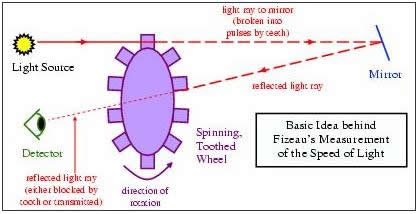
You are here: Home >> History of Light >> Galileo >> Counting c
Olaus Roemer - 1666
The first successful measurements of the speed of light were astronomical. In 1676 the Danish astronomer Olaus Roemer noticed a delay in the eclipse of a moon of Jupiter when it was viewed from the far side as compared with the near side of earth's orbit. Assuming the delay was the travel time of light across the earth's orbit, and knowing roughly the orbital size from other observations, he divided distance by time to estimate the speed.
The existence of the EtherJames Bradley - 1725
English physicist James Bradley obtained a better measurement in 1729. Bradley found it necessary to keep changing the tilt of his telescope to catch the light from stars as the earth went around the sun. He concluded that the earth's motion was sweeping the telescope sideways relative to the light that was coming down the telescope. The angle of tilt, called the stellar aberration, is approximately the ratio of the orbital speed of the earth to the speed of light. (This is one of the ways scientists determined that the earth moves around the sun and not vice versa.)
Armand H.L. Fizeau - 1849
 In the mid-19th century, French physicist Armand Fizeau directly measured the speed of light by sending a narrow beam of light between gear teeth in the edge of a rotating wheel. The beam then travelled a long distance to a mirror and came back to the wheel where, if the spin were fast enough, a tooth would block the light. Knowing the distance to the mirror and the speed of the wheel, Fizeau could calculate the speed of light. During the same period, the French physicist Jean Foucault made other, more accurate experiments of this sort with spinning mirrors.
In the mid-19th century, French physicist Armand Fizeau directly measured the speed of light by sending a narrow beam of light between gear teeth in the edge of a rotating wheel. The beam then travelled a long distance to a mirror and came back to the wheel where, if the spin were fast enough, a tooth would block the light. Knowing the distance to the mirror and the speed of the wheel, Fizeau could calculate the speed of light. During the same period, the French physicist Jean Foucault made other, more accurate experiments of this sort with spinning mirrors.